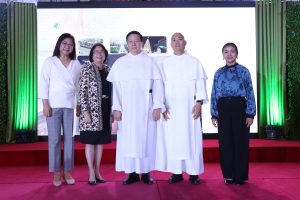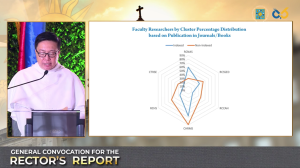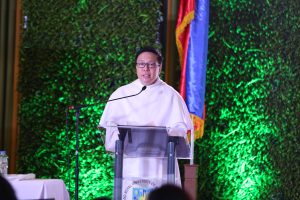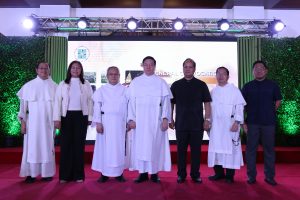



On the Feast Day of the Nativity of the Blessed Virgin Mary, September 8, 2022, the University of Santo Tomas held a hybrid General Convocation for the Rector’s Report at the Dr. Robert Sy Grand Ballroom of the Bl. Buenaventura Garcia Paredes O.P. Building. Very. Rev. Fr. Richard G. Ang, O.P., Ph.D., delivered his report on the University’s achievements from January 2020, when he began serving as Acting Rector, to July 2021, or the first five academic terms of his Rectorship.
The Master of the Order of Preachers and UST Chancellor Very Rev. Fr. Gerard Francisco P. Timoner, III, O.P., first confirmed Father Ang’s appointment as UST’s eighth Filipino Rector on May 7, 2020. However, since that was at the height of the pandemic, the traditional Installation Rites usually held at the start of the academic year had to be postponed to May 13, 2021, coinciding with the Feast of Our Lady of Fatima.
Upon his installation, Fr. Ang stated seven priorities for leadership, where he committed to harnessing technology in preparation for Industry 4.0; advancing synergy among disciplines, units, and institutions; enriching the research ecosystems of the University; optimizing advances made in internationalization; fostering a stronger industry-academe-alumni partnership; advocating wellness of being; and managing resources for strategic expansion. Together, these points comprise “UST Vision 2024 and Beyond”, agenda that are entrenched in the Key Result Areas and Key Performance Indicators of the directional areas.
“They will be carefully planned and regularly monitored to ensure that, as a University, we move together in one mind and one spirit,” vowed the Father Rector.
“As a 411-year-old Catholic institution, we have adjusted, evolved, and transformed the way we do things at the University. The centerpiece of this presentation is the story of how UST went through a continuum of necessary, relevant, and multi-dimensional challenges, and how we managed to confront conditions of uncertainty and unpredictability from a position of faith, courage, and resiliency,” said Fr. Ang.
The Father Rector gave highlights from each of the Nine Strategic Directional Areas (SDAs) and the UST Hospital:
Leadership and Governance
Remembering that his term as Acting Rector had barely started when the COVID-19 pandemic and the resulting community quarantines began in early 2020, Fr. Ang highlighted the creation of Task Force Veritas, whose goal was to ensure the continuous delivery of services during the transition of University operations to the virtual mode while complying with health restrictions amid the pandemic.
The University also implemented fully online enrollment processes; reviewed the table of fees; allowed staggered payments until December; refunded laboratory fees and other in-person related payments; did not increase tuition fees for incoming freshmen; extended scholarships; created a committee on negotiations with telecommunications companies to address internet connectivity concerns; initiated a corporate subscription of the University to Zoom; allowed work-from-home and skeleton workforce arrangements for employees, ensuring that no support staff was laid off due to the pandemic; secured vaccines for her stakeholders in coordination with the local government of Manila, successfully signed the Collective Bargaining Agreement 2020 with the UST Faculty Union, among many other initiatives.
Amid the transition, the University continued to join and excel at national and international quality assurance (QA) undertakings, such as the Quacquarelli-Symonds Ratings, which gave UST the first five-star rating in the Philippines; and the ASEAN University Network Quality Assurance (AUN-QA), which granted UST institutional certification until 2025; the Times Higher Education Impact Rankings, which named UST 3rd among Philippine HEIs. It has also maintained and improved accreditation levels from Philippine Association of Colleges and Universities Commission on Accreditation (PACUCOA) and the Philippine Accrediting Association of Schools, Colleges and Universities (PAASCU).
UST also completed its remote ISO 9001:2015 Surveillance Audit on July 8, 2020, and its 3rd Re-certification Audit on July 3 and 4, 2021, as conducted by TÜV SÜD PSB Philippines, Inc.
“All these achievements are not the accomplishments of one person or one unit, but rather the product of our communal efforts. As Helen Keller wrote, alone we can do so little, but together we can do so much,” said Fr. Ang.
Thomasian Identity
The pandemic occurred during the 500th year of the arrival of Christianity in the Philippines, the 800th death anniversary of St. Dominic, and the 50th founding anniversary of the Dominican Province of the Philippines. Despite this, “The University, through the Office of the Vice Rector for Religious Affairs, pursued a robust faith formation program and fostered community engagement in an organic and dynamic faith ecosystem through various spiritual, pastoral, and service programs.”
Online Eucharistic Celebrations, commemorations, recollections, virtual Paskuhan festivities and Send-offs, as well as symposia and other gatherings on interreligious dialogue were also held.
Teaching and Learning
With more than 40,000 students and almost 3000 academic and support staff, the University-wide shift to the Enhanced Virtual Mode (EVM) of Instruction, led by the Office of the Vice Rector for Academic Affairs, included adjustments made in instruction, including reaching out to learners with limited connectivity through free pocket wi-fi units, subsidized PLDT SMART internet plans, and learning packets in electronic or optional printed or flash drive forms sent via courier service.
“UST also expanded its roster of e-learning specialists to render assistance in addressing the teaching and learning needs of academic units. The appointment of pedagogical leads was intended to provide further support to teachers,” said Fr. Ang.
The Father Rector also commended that the University maintained 59 accredited academic programs by PACUCOA and PAASCU, that several licensure examinations were topped by Thomasians, and that there was an increase in the number of academic staff with awards and recognitions at the national and international levels.
Research and Innovation
The pandemic may have temporarily paused or limited in-person access to laboratories and field work, but productivity in terms of publications in both indexed and non-indexed journals increased, with a total of 323 publications for A.Y. 2020-2021. Furthermore, 62 researchers acquired external grants from national funding agencies, while 18 researchers obtained international funding from foreign agencies.
Fr. Ang also highlighted the TOMASInno Innovation Center’s launch and blessing, as well as the groundbreaking of the Dr. Tony Tan Caktiong Innovation Center, which will include fabrication and prototyping centers, as well as innovation and product development hubs and laboratories at the rising UST Santa Rosa campus.
“In the very near future, UST Santa Rosa will be able to complement the research activities of the España campus by becoming a techno and innovative hub in Laguna, following the model of Pennsylvania State University and Cornell University in the USA,” shared Fr. Ang, who added that the Assistant to the Rector for UST Santa Rosa, Prof. Philipina Marcelo, Ph.D., was coordinating with experts from the USA who will help with this forthcoming arrangement in Santa Rosa.
Resource Management
The University, through the Office of the Vice Rector for Finance and the Human Resource Department, utilized its financial and human resources with flexibility, allowing employees to have alternative work arrangements with their health monitored through the Thomasian Online Medical Services and Support (ThOMedSS) portal and work hours managed through the UST Support Staff Access Portal (USSAP)
Reviewing fees was also done to balance the students’ welfare and the University’s need to maintain sustainability.
Major construction projects under the Facilities Management Office were also completed (Bl. Pier Giorgio Frassati Building, UST Link Bridge) or neared completion by the end of A.Y. 2020-2021, such as the UST Manila Stormwater Drainage Improvement, the UST General Santos Filial House of San Martin De Porres and the UST GenSan Main Building, the renovation of the San Martin de Porres Building, and the UST Sta. Rosa Campus.
“Resource Management, whether human, physical, or financial, will be a major challenge in the coming years because the University is going for expansion. The agendum on industry-academe-alumni partnership will be a partial response to this task,” said Fr. Ang.
Public Presence
Through the Office of Public Affairs, the Communications Bureau, and the Office for Alumni Relations under the Office of the Secretary-General, dynamic communication and stakeholder engagement strategies were deployed to maximize opportunities during the pandemic.
Among the highlights were almost two billion pesos in free PR value and over 700 million pesos in free advertisement value accumulated through news segments and press releases published about UST’s COVId-19 response, and other events, programs, and achievements regarding internationalization, teaching expertise, research expertise, advocacies, involvement in policy formulation, and alumni activities. Some of these events and programs were in partnership with the diplomatic corps, cultural agencies and religious organizations, and other national and international institutions.
Community Development and Advocacy
The Father Rector commended the active participation of the Thomasian community in the University’s community development programs, citing 37,469 students, 171 student organizations, and 2,387 academic staff who have joined or contributed.
Community engagement activities, led by the SIMBAHAYAN Community Development Office, have moved online, including Pistang Tomas, which had various livestreams and capacity-building sessions on livelihood skill development; Siglang Tomas, a health advocacy project through health education; AlerTomas, which conducted research work and dialogues in support of the encyclical Laudato Si’; and the launch of the “Journeying with Communities: A Community Engagement and Organizing Handbook for University Extension Workers”.
Student Welfare and Support
Through dialogues with students at the level of the central and unit offices and the constant updating of the Frequently Asked Questions page, the University listened to and addressed student concerns stemming from the various consequences of lockdown. Policies and procedures for enrolment, shifting, or re-channeling, and interim provisions on scholarships and student welfare and discipline were also reconsidered.
The University, in A.Y. 2020-2021, also had over 3000 beneficiaries of various scholarship grants, which were not cancelled during the pandemic. Student Services offered by the Counseling and Career Center, Library, Registrar, Health Service and the Office for Student Affairs also transitioned to an online platform, including the UST Application Rating (USTAR) as a temporary replacement to the UST Entrance Test (USTET). For A.Y. 2023-2024, USTET has been reinstated.
“In the coming days, we will give more attention to our safe learning spaces in the physical and virtual sense for the benefit of our students,” said Fr. Ang.
Internationalization
The Office of International Relations and Programs oversaw various forms of virtual student mobility (VSM), like virtual exchanges (VE) or collaborative online international learning (COIL), webinars, virtual conferences, symposia and e-for a. For A.Y. 2020-2021, 17126 students participated in VSMs despite the pandemic. Six new transnational research collaborations (TNRs) were also established in health and social sciences in the same A.Y., which brings the total of ongoing TNRs to 16.
Nine inbound faculty from various foreign institutions were appointed as visiting professors in UST, while three outbound UST academic staff were appointed as international faculty members, including Asst. Prof. Gina Lontoc, Ph.D. (visiting lecturer at the University of East Anglia, UK), Asst. Prof. Donata Acula (journal reviewer at the Institute of Electrical and Electronics Engineers, USA), Asst. Prof. Lawrence Decamora (Course Lecture Developer of 17 Java Programming Modules at the Fitzwilliam Institute, UK; Consultant at GreyCampus, USA and India; and Course Lecture Developer at Eduonix Learning Solutions, India).
“The University’s performance amid the challenges brought about by the pandemic indicated that Internationalization remained robust.”
The UST Hospital
The Father Rector thanked the UST Hospital administrators, led by its CEO Rev. Fr. Julius Paul Factora, O.P., Medical Director Dr. Charito Malong-Consolacion, Director for Finance Rev. Fr. Roman Santos, O.P., and Director for Administration Prof. Analin E. Porto, DrEM, for responding to the challenges of the pandemic. Included among the initiatives are the manpower audit, the gradual opening of offices and ancillary services, and the opening of the Domus Mariae to USTH employees.
Installation of exhaust fans and air purifiers to improve ventilation in the hospital facilities and public areas, addition of area zoning and acrylic barriers, conversion of COVID wards, provision of less expensive RT-PCR tests and drive thru swab testing, the signing of the USTH CBA, among others, are also part of the USTH’s response.
Another highlight was the partial opening of the St. John Paul II Building, a new structure for the UST Hospital Complex, which now houses the administrative offices and some ancillary services like the laboratory.
One Community
“We accompanied our students in their struggles, and as we brave each passing day, we learned the value of meaningful connections with fellow members of the Thomasian community. In the Holy Spirit’s Indwelling, someone’s joy becomes ours, someone’s sorrow and pain become ours as well, and in the process, we experience what it means to be truly blessed with life, health, friends, and family. The pandemic taught us what it means to be a Thomasian community – a community that looks out for the welfare of each other during a time of great uncertainty, guided by the virtues of the Tria Haec: Faith, Hope, and Love,” The Father Rector reflected.
Fr. Ang further emphasized the values of being grateful and being open to others, saying “Gratitude and empathy are the principles that allow us to redirect our focus on the things that we can change. Together, they inspire change from within ourselves, driving us to serve with humility and sincerity, and allowing us to touch the lives of those around us in ways we never thought possible.”
“More than a time of hopelessness, the pandemic is a defining moment that brought out the best in us. It is a time that brought Thomasians closer to one another and closer to God. To the Thomasian community, thank you for your unceasing prayers and support for the University during these tough times,” said Fr. Ang.
The Rector’s Report remains available for public viewing through the official UST Facebook page and the full narrative will be submitted to Rome.




